A Buyer’s Guide to Modern IGA


Unlocking Effective Identity Governance:
A comprehensive buyer's guide to modern IGA solutions
In recent years, businesses have faced a deluge of change driven by the rapid advancement of cloud technology, elevated security risks, and constant shifts in the technology landscape. Amid these challenges, inflexible and outdated Identity Governance and Administration (IGA) technology has compounded the difficulties of managing identity security.
Security leaders have wrestled with the escalating proliferation of identities and the need to mitigate risks within expanding identity domains, making a modernized approach to IGA imperative. If you are considering transforming your IGA program, selecting the appropriate IGA solution can be complex. Enterprises that proactively embark on the evaluation process before a crisis arises substantially increase their likelihood of making the right choice. To support your evaluation efforts and facilitate the selection of a platform that aligns with your business and security KPIs, we have compiled an IGA Solution Buyer's Guide.
This guide discusses:
The modernization of IGA
What makes a modern IGA solution?
IGA Drivers
IGA Solution Scorecard
The modernization of IGA
IGA forms the bedrock of modern enterprise security. When correctly deployed, it regulates access to data and business transactions for both user and machine identities. IGA processes and policies also establish the groundwork for Zero Trust security across cloud, hybrid, and on-premises architectures.
Imagine having the power to seamlessly manage user identities, control access, and ensure compliance across all corners of your organization, whether they're employees, partners, or even automated systems. An IGA solution is the guardian of your digital assets, safeguarding sensitive data and preventing unauthorized access in the face of ever-evolving cyber threats.
But an IGA solution is not just about security but also efficiency. An IGA solution can streamline your identity-related processes, from onboarding to offboarding, with automation and self-service capabilities that reduce your administrative overhead. Empowering your IT teams to focus on strategic initiatives instead of routine tasks while ensuring access permissions remain accurate.
Because of the escalation in remote work and the widespread adoption of cloud technologies, the need for a comprehensive identity management solution has reached an unprecedented level of importance. Modern IGA solutions are designed to adeptly navigate the intricate landscape of hybrid environments, cloud-based applications, and remote accessibility. This positioning affords your organization the versatility required to excel within the contemporary workplace.
Furthermore, an elevated emphasis on regulatory compliance has emerged as a pivotal priority. By implementing an appropriate solution, you can effectively steer your organization towards adherence to data protection regulations and industry benchmarks, fortified by resilient audit trails, comprehensive reporting mechanisms, and the consistent enforcement of policies. This proactive approach helps mitigate potential financial and reputational vulnerabilities associated with non-compliance while demonstrating dedication to the conscientious management of data.
What makes a modern IGA solution?
What constitutes a modern IGA solution? As highlighted in a recent Forrester report, organizations transitioning from manual identity management systems are looking for a solution that will manage access to sensitive data and applications without inhibiting business agility.
The newest generation of IGA solutions is designed to advance operational workflows, diminish the bottlenecks associated with compliance, and seamlessly embrace future IT trends.
A modern IGA solution should possess the following attributes:
Incorporates workflow automation
Rooted in cloud-native architecture
Emphasizes flexibility, adaptability, and extensibility
Converges disparate technologies and functionalities
With each passing day, more cloud infrastructure and applications are introduced, and with the severity and frequency of breaches on the rise, organizations require a cloud-architected solution capable of controlling access, safeguarding critical assets, and minimizing risks. Given the high stakes involved, selecting an IGA solution necessitates meticulous consideration. The correct choice can unlock enhanced security, cost-efficiency, and operational efficacy.
IGA Drivers
To navigate the IGA landscape, it's imperative to recognize the significance of technology considerations within the broader context of addressing your organization's business challenges. The unique nature of IGA necessitates a thoughtful approach to these
considerations, particularly during the initial purchase stage.
Throughout your solution evaluation journey, you’ve likely identified specific needs within:
Identity provisioning
Identity governance and compliance, or
Privileged Access Management
For clarity,
Provisioning involves managing user accounts across various enterprise systems,
Governance and compliance entail periodic auditing and recertification to ensure appropriate user entitlements, and
Privileged access management encompasses accounts with administrative or "super user" privileges.
While it's typical for organizations to initially concentrate on a single aspect of IGA, the genuine worth of an IGA solution becomes apparent when investments are directed towards solutions that encompass all three aspects. This is primarily due to the shared processes and data required for each of these functions. Consequently, solutions that provide a cohesive and integrated data model, alongside consistent connectivity frameworks, inherently amplify the return on investment (ROI) by easily adapting to the growth of your organization.
Furthermore, the integration of identity and governance solutions yields additional ROI advantages by connecting provisioning, governance, and privileged access functionalities. This integrated approach alleviates challenges that arise due to disconnected components, thereby streamlining activities during the initial implementation phase and the ongoing maintenance stages.
IGA Solution Scorecard
Regardless of the difficulties you may encounter and the intricate nature of the choices before you, identity governance needs significant consideration within organizational frameworks. Overlooking the importance of your decision could potentially leave you vulnerable to data breaches, compromised information, penalties, as well as legal and reputational repercussions.
Still, it's crucial to acknowledge that not every solution will seamlessly align with your organization's unique needs. By meticulously assessing particular elements during the evaluation process, you can substantially diminish the potential risks associated with a troublesome implementation.
Rate the solution on a scale of 1 - 5.
One = strongly disagree, two = disagree, three = neutral, four = agree, and five = strongly agree.
If the solution scores a 40-50, the solution possesses the capabilities you need for a strong IGA solution.
Can the solution provide the data to prove and certify who has access to what resources?
Does the solution provide an access provisioning process in a "closed loop," and can we provide evidence of consistent access granting and revocation?
Does the solution establish and enforce access policies?
Does the solution maintain accurate records of when users access applications?
Does the solution control the utilization of machine and service accounts?
Does the solution have established measures to enforce the segregation of duties (SoD) and mitigate improper access through the workflow approval process?
Does the solution simplify users' and managers' access request initiation and approval process?
Does the solution make granting and reviewing fine-grained access to users quick and efficient?
Can the solution thoroughly and comprehensively carry out scheduled access certification reviews?
Does the solution provide your managers with the necessary information to promptly and securely authorize or certify access requests?
Does the solution enable automated role design and security simulation to prevent the introduction of violations into your business applications proactively?
Does the solution provide access audit analytics to assess the cybersecurity controls' efficacy, ensuring prevention of external threats and prompt completion of remediation tasks?
In your pursuit of effective IGA solutions, remember that the ultimate success of your tool depends not only on its technological capabilities but also on its alignment with your organization's distinct business needs. By recognizing the interconnected nature of technology and business challenges within the IGA space, you can make informed decisions that drive enhanced identity governance, improved security, and efficient compliance across your organization.
Recommended Resources

Definitive Guide to Modern IAM
Integrating IGA, AM, and PAM creates a central hub of policy, governance, and enforcement of identity security. With an integrated policy-based approach, a privileged access request can be managed within the organization’s IGA policies.

The Policy-based Identity Governance Guide
Many organizations grapple with IGA processes, like creating and managing roles, assigning and reviewing access entitlements, and handling access requests. The primary cause is that organizations follow the wrong approach to IGA, particularly around creating and managing roles.

Advanced Audit Analytics
Auditors must enhance their capabilities to effectively audit modern digital platforms. Businesses are adopting new technologies such as Cloud Computing, Artificial Intelligence, and Robotic Process Automation that require new and advanced audit analytics.

